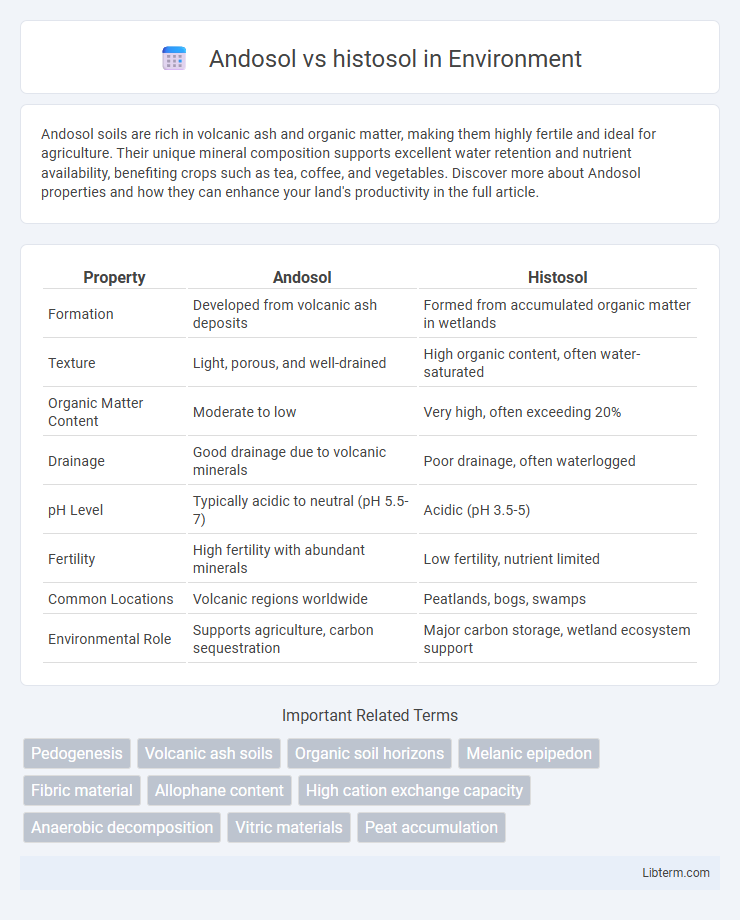Andosol soils are rich in volcanic ash and organic matter, making them highly fertile and ideal for agriculture. Their unique mineral composition supports excellent water retention and nutrient availability, benefiting crops such as tea, coffee, and vegetables. Discover more about Andosol properties and how they can enhance your land's productivity in the full article.
Table of Comparison
| Property | Andosol | Histosol |
|---|---|---|
| Formation | Developed from volcanic ash deposits | Formed from accumulated organic matter in wetlands |
| Texture | Light, porous, and well-drained | High organic content, often water-saturated |
| Organic Matter Content | Moderate to low | Very high, often exceeding 20% |
| Drainage | Good drainage due to volcanic minerals | Poor drainage, often waterlogged |
| pH Level | Typically acidic to neutral (pH 5.5-7) | Acidic (pH 3.5-5) |
| Fertility | High fertility with abundant minerals | Low fertility, nutrient limited |
| Common Locations | Volcanic regions worldwide | Peatlands, bogs, swamps |
| Environmental Role | Supports agriculture, carbon sequestration | Major carbon storage, wetland ecosystem support |
Introduction to Andosol and Histosol
Andosols are volcanic ash soils characterized by high organic matter content, excellent water retention, and significant fertility, making them ideal for agriculture in volcanic regions. Histosols are organic-rich soils, primarily composed of accumulated peat or muck, formed in waterlogged environments with slow decomposition rates, supporting unique wetland ecosystems. Both soil types exhibit distinct physical and chemical properties that influence land use, crop production, and environmental management.
Formation Processes of Andosol and Histosol
Andosols form primarily from volcanic ash deposits through rapid weathering and allophane formation, leading to high porosity and low bulk density soils rich in amorphous materials. Histosols develop in waterlogged environments where organic matter accumulates faster than it decomposes, resulting in thick layers of peat or muck composed mainly of partially decomposed plant material. The contrasting formation processes highlight Andosols' mineral-rich volcanic origin and Histosols' organic-rich, anaerobic conditions driven by prolonged saturation.
Key Physical Characteristics
Andosols are characterized by high porosity, low bulk density, and a dark, volcanic origin, making them highly fertile with excellent water retention and aeration properties. Histosols consist predominantly of organic matter, displaying low bulk density, high water retention, and poor drainage, which leads to saturation under many conditions. The physical structure of Andosols promotes root penetration and microbial activity, whereas Histosols often have a spongy texture and are prone to compression and anaerobic conditions.
Chemical Properties Comparison
Andosols exhibit high levels of allophane and imogolite, contributing to strong phosphorus retention and high cation exchange capacity (CEC), whereas Histosols are rich in organic matter with low mineral content, resulting in low CEC but high nutrient-holding capacity due to humic substances. Andosols typically have a near-neutral to slightly acidic pH, promoting nutrient availability, while Histosols tend to be highly acidic, often limiting nutrient accessibility. The chemical composition of Andosols favors rapid nutrient cycling, in contrast to Histosols, where slow organic matter decomposition influences nutrient release rates.
Distribution and Geographic Occurrence
Andosols predominantly occur in volcanic regions such as Japan, Indonesia, and parts of the Pacific Northwest in the United States, favoring areas with recent volcanic ash deposits. Histosols are mainly found in waterlogged environments like peat bogs and marshes, with extensive distributions in northern latitudes including Canada, Scandinavia, and parts of Russia. The distinct formation conditions result in Andosols being common near active volcanic landscapes, whereas Histosols dominate in organic-rich, saturated soils characteristic of cold or temperate climates.
Typical Vegetation and Land Use
Andosols, formed from volcanic ash, typically support dense forests and agricultural crops like tea, coffee, and root vegetables due to their high fertility and organic matter content. Histosols, rich in organic material from decomposed plant remains, are commonly found in wetlands and peat bogs, supporting mosses, sedges, and other hydrophytic vegetation while being used mainly for peat extraction and limited agricultural activities like cranberry farming. Land use on Andosols emphasizes intensive farming and forestry, whereas Histosols are often conserved for biodiversity or used for specialized cultivation under drained conditions.
Fertility and Agricultural Potential
Andosols exhibit high fertility due to their volcanic ash content, providing excellent nutrient retention and good water-holding capacity, making them ideal for diverse crops. Histosols, composed primarily of organic matter, have variable fertility with often limited nutrient availability and drainage challenges, restricting their agricultural potential. Effective management practices can enhance crop productivity on both soils, but Andosols generally offer more reliable agricultural performance.
Environmental Functions and Challenges
Andosols, characterized by volcanic ash content, excel in carbon sequestration due to high organic matter stabilization and support robust water retention, crucial for mitigating erosion and sustaining agriculture in volcanic regions. Histosols, defined by accumulated organic peat, function as significant carbon sinks but pose environmental challenges such as greenhouse gas emissions when drained or disturbed, impacting climate regulation. Both soils require tailored management strategies to balance their ecosystem services with risks like nutrient leaching in Andosols and degradation or oxidation in Histosols.
Management and Conservation Practices
Andosol soils require careful management to maintain high organic matter content and prevent nutrient leaching, often involving organic amendments and controlled drainage systems. Histosol soils demand conservation practices that minimize oxidation and subsidence, such as water table management through periodic flooding and the use of cover crops to reduce erosion. Both soil types benefit from tailored nutrient management plans to sustain productivity while preserving soil structure and carbon stocks.
Summary and Future Perspectives
Andosols, characterized by volcanic ash content and high fertility, contrast with Histosols, which are organic-rich soils formed from decomposed plant material in wet environments. Future research aims to optimize land use by leveraging Andosols' nutrient retention and Histosols' carbon sequestration potential to enhance sustainable agriculture and climate change mitigation. Advances in soil management practices and monitoring technologies will improve the understanding of these soils' roles in ecosystem services and global biogeochemical cycles.
Andosol Infographic

 libterm.com
libterm.com